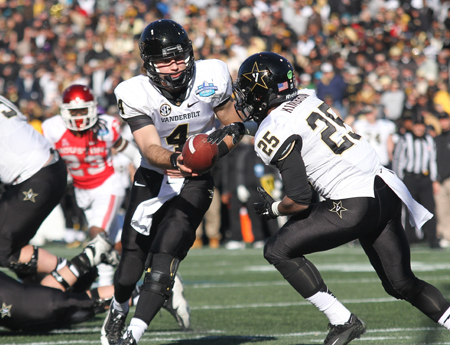SEC Readying to Make A Run To Glory

On paper, the SEC Network looks like television’s version of the perfect two-man backcourt basketball combination. Parent ESPN is the self-proclaimed “worldwide leader in sports.” And the Southeastern Conference scores with ratings regularly, its schools a picture of college basketball stardom and football domination.
No wonder ESPN execs have expressed confidence that the SEC Network—which debuts Aug. 21 to begin a 20-year deal—will get wide carriage beyond the conference’s 11-state footprint.
That, of course, is on paper. In reality, it’s been rough for college conferences to get carriage for their own networks. The Big Ten Network launched seven years ago to 17 million homes, with only DirecTV on board. Dish signed shortly thereafter but it took another year to sign up Time Warner Cable, Cablevision and Charter. The Pac-12 conference, which launched in August 2012, is still fighting for carriage for its bundle of networks.
But ESPN believes name recognition and star power will propel the newest channel in the ever-increasing sports network space to succeed with cable and satellite providers.
“This is not a regional network. This is a national network,” said ESPN president John Skipper during last May’s announcement press conference. “There’s a lot of SEC fans in California, Michigan, Connecticut, Nebraska. We expect to be in all those places widely distributed with this network.”
Skipper sees the SEC Network getting into around 75 million homes, which would put it on par with its ESPNU channel.
In fact, the SEC’s devoted fan base and national recognition—to go along with sports’ reputation for preferred live viewing—will work in ESPN’s favor. Having Heisman Trophy winner and SEC legend Tim Tebow as a face of the network won’t hurt either.
Broadcasting & Cable Newsletter
The smarter way to stay on top of broadcasting and cable industry. Sign up below
Here’s the Pitch
According to Sports Business Journal, ESPN is seeking $1.30 per subscriber in the conference’s 11-state footprint, which would be about 30% higher than the Big Ten Network and Pac-12 Network get in their respective footprints.
At presstime, the SEC Network only counts AT&T U-verse and its 4.5 million subscribers. But according to multiple reports, the net is close to a deal with Dish Network that would add roughly 14 million subscribers. The total would put SEC Network roughly on par with how the Big Ten Network launched; BTN grew to 30 million after the first month.
“We continue to have productive conversations with our partners, but there is nothing to announce at this time,” said an ESPN/SEC Network representative.
Two other top cable operators—Comcast and Time Warner Cable—have major footprints in the SEC market, which could give ESPN a major advantage in its discussions. The SEC Network’s opening football game, on Aug. 28, will be between two schools in Time Warner Cable markets, South Carolina and Texas A&M. The second game will feature Vanderbilt and Temple, which are both in Comcast markets.
Football is the SEC’s national bread and butter; before conference school Auburn lost the BCS national championship in January, SEC schools won the title seven straight seasons. But the conference’s popularity goes beyond the gridiron: SEC games account for nine of the 10 most-viewed regular-season college baseball and softball games in ESPNU history.
Ultimately, time will tell whether the SEC’s decision to go all-in with ESPN was the right one. The SEC-ESPN pact—the network will be owned by ESPN—represents the third different management structure with these college conference networks.
The Big Ten Network is owned by both the conference and 21st Century Fox (Fox owns a 51% stake), but the Pac-12 conference owns 100% of its national and regional networks. The Big Ten Network is carried nationally on DirecTV, Dish Network and AT&T U-Verse, and regionally on nearly every cable system in the conference’s footprint. The upcoming additions of Maryland and Rutgers to the Big Ten are seen as a way for the network to expand even further east.
Pac-12 Hopes to Go Direct
BTN has worked its way up to over 90 million homes. The Pac-12 Network is still finding its way. It remains without carriage on major MSOs Charter, Verizon FiOS and most publicly, DirecTV.
The two companies have argued, sometimes publicly: Pac-12 commissioner Larry Scott took time during the conference’s media day last summer to call out the satcaster for not carrying the channel. The conference even ran a multimedia advertising campaign last fall urging DirecTV subscribers to switch to another provider.
The problem comes with Pac-12 wanting to be part of a tier with other like channels, and DirecTV preferring to make it a pay-per-view or al a carte channel.
It stands to reason that the two companies will eventually come to a mutually beneficial agreement. DirecTV, which as the exclusive provider of the NFL’s Sunday Ticket package, likes to tout itself as a leader in that space. Of the satellite provider’s 20 million subscribers nationwide, roughly 4 million reside in the Pac-12’s footprint.
For the Pac-12, a deal with DirecTV could see carriage deals with Charter and Verizon follow suit.
The SEC Network and ESPN, on the other hand, expect to have a much easier route to daylight.










